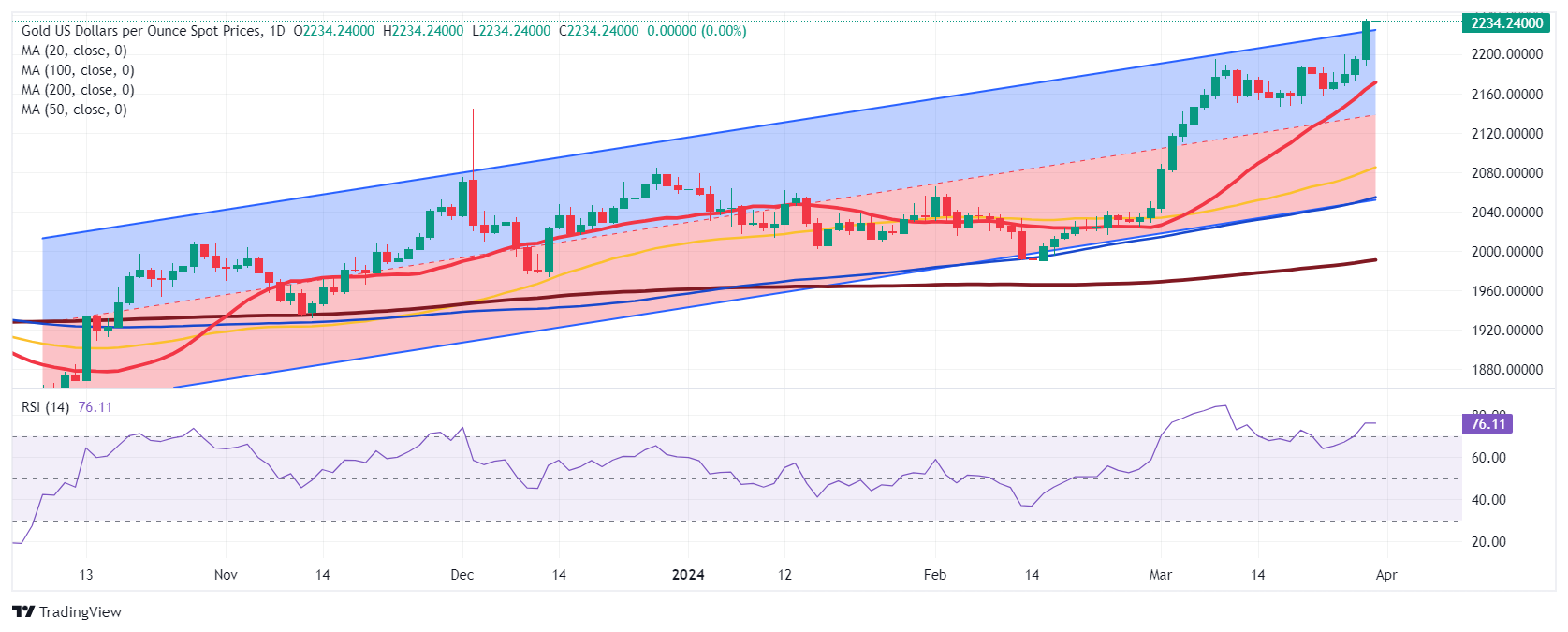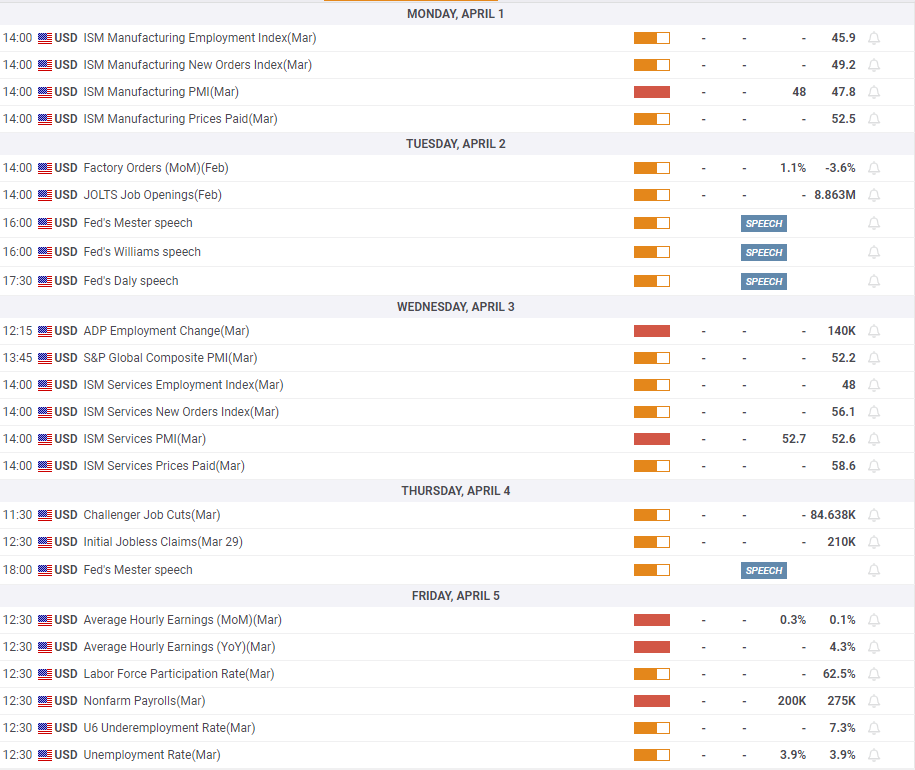Gold Weekly Forecast: Persistent US Dollar strength fails to discourage bulls
- Gold came within a touching distance of a new all-time high.
- Technical overbought conditions could discourage buyers in the near term.
- US labor market data for March could drive XAU/USD’s action next week.
Gold ignored the persistent US Dollar (USD) strength this week and climbed above $2,200. As market focus shifts to next week’s key macroeconomic data releases from the US, XAU/USD’s technical outlook suggests that the pair could stage a technical correction before the next leg higher.
Gold price gains traction in holiday-shortened week
Following the impressive recovery seen in the second half of the previous week, the US Dollar (USD) Index, which tracks the USD’s performance against a basket of six major currencies, turned south at the beginning of the week and allowed XAU/USD to close in positive territory on Monday. Hawkish comments from Federal Reserve (Fed) officials, however, made it difficult for the pair to gather further bullish momentum. Atlanta Fed President Raphael Bostic said that he was expecting the US central bank to lower the policy rate one time this year and Fed Governor Lisa Cook added that there were risks to easing the policy “too much or too soon, as well as too late.”
Gold climbed to $2,200 during the European trading hours on Tuesday but reversed its direction in the second half of the day, with the upbeat data from the US helping the USD hold its ground. Durable Goods Orders in the US increased by 1.4% on a monthly basis in February following the 6.9% contraction recorded in January.
In the absence of fundamental drivers, Gold regained its traction and advanced above $2,200. Although hawkish comments from Fed Governor Christopher Waller supported the USD in the second half of the week, technical buyers refused to give up control while XAU/USD held above $2,200.
Waller noted that the Fed was not in a rush to lower the policy rate, arguing that it might be appropriate to hold the restrictive stance for longer than previously thought to help inflation return to the 2% target on a sustainable trajectory.
On Thursday, the Bureau of Economic Analysis (BEA) announced that the annualized real Gross Domestic Product (GDP) growth for the fourth quarter was revised higher to 3.4% from 3.2% in the previous estimate. Other US data showed that there were 210,000 Initial Jobless Claims in the week ending March 23.
Inflation in the US, as measured by the change in Personal Consumption Expenditures (PCE) Price Index, increased slightly to 2.5% on a yearly basis in February, data released by the US Bureau of Economic Analysis (BEA) showed Friday. The reading met the consensus forecast and followed January’s 2.4% increase. The Core PCE Price Index, which excludes volatile food and energy prices, rose at an annual pace of 2.8%, in line with market expectations.
Gold price faces a two-way risk next week
The US economic calendar will offer several high-tier data releases that could influence the market pricing of the Fed rate outlook and drive the XAU/USD action.
On Monday, the ISM will publish the Manufacturing PMI data for March. The headline PMI is forecast to edge slightly higher to 48. A reading above 50 could provide a boost to the USD with the immediate reaction. Investors will also pay close attention to the Prices Paid Index, the inflation component of the PMI survey. In January and February, the Prices Paid Index held above 50, after staying below that level for eight consecutive months. In case the inflation component retreats below 50 and points to a pullback in the manufacturing sector’s input prices, the USD could struggle to find demand even if the main PMI comes in better than expected.
On Tuesday, the Bureau of Labor Statistics (BLS) will publish the JOLTS Job Openings data for February. Unless this data diverges significantly from January’s print of 8.86 million, the market reaction is likely to remain muted.
The ADP Employment Change and the ISM Services PMI data will be featured in the US docket on Wednesday. A disappointing ADP data could cause markets to anticipate a weak jobs report on Friday and make it difficult for the USD to find demand. Later in the day, the market reaction to the Prices Paid Index of the Services PMI survey could resemble the reaction to Monday’s PMI report.
Finally, the BLS will release the highly-anticipated labor market report on Friday. Nonfarm Payrolls (NFP) are forecast to rise 200,000 in March following the 275,000 increase recorded in February. The Unemployment Rate is seen holding steady at 3.9%, while the monthly wage inflation, as measured by the change in the Average Hourly Earnings, is anticipated to rise to 0.3% on month from 0.1%.
Although the February NFP increase beat the market expectation by a wide margin, the USD came under selling pressure because January and December prints got revised lower. In case March NFP data comes in stronger than forecast and there are no noticeable revisions to the past readings, the USD could outperform its rivals and weigh on XAU/USD with the knee-jerk reaction. On the other hand, a weak NFP growth could hurt the USD. An upbeat NFP accompanied by downward revisions could not allow the USD to capitalize on the data.
The CME FedWatch Tool shows that markets are currently pricing in a nearly 40% probability that the Fed will leave the policy rate unchanged in June. If the jobs report highlights tightening conditions in the labor market, investors could refrain from betting on a rate cut in June and could even doubt that the Fed will lower the policy rate by a total 75 basis points this year even though that’s what the last Summary of Economic Projections suggested. In this scenario, XAU/USD could make a deep correction. In case the report keeps the expectations for a rate reduction in June by delivering a weak NFP, Gold could gather bullish momentum.
Gold technical outlook
The Relative Strength Index (RSI) indicator on the daily chart climbed above 70 and XAU/USD briefly surpassed the upper limit of the ascending regression channel coming from October, currently located near $2,220. Buyers could move to sidelines and wait for the pair to make a correction before deciding whether the rally has more legs. The 20-day Simple Moving Average (SMA) aligns as first support at $2,160 before $2,135 (mid-point of the ascending channel).
It’s not easy to set a bullish target for Gold but the round level at $2,300 could be the next resistance in case the precious metal holds above $2,220 and confirms that level as support.

Nonfarm Payrolls FAQs
Nonfarm Payrolls (NFP) are part of the US Bureau of Labor Statistics monthly jobs report. The Nonfarm Payrolls component specifically measures the change in the number of people employed in the US during the previous month, excluding the farming industry.
The Nonfarm Payrolls figure can influence the decisions of the Federal Reserve by providing a measure of how successfully the Fed is meeting its mandate of fostering full employment and 2% inflation. A relatively high NFP figure means more people are in employment, earning more money and therefore probably spending more. A relatively low Nonfarm Payrolls’ result, on the either hand, could mean people are struggling to find work. The Fed will typically raise interest rates to combat high inflation triggered by low unemployment, and lower them to stimulate a stagnant labor market.
Nonfarm Payrolls generally have a positive correlation with the US Dollar. This means when payrolls’ figures come out higher-than-expected the USD tends to rally and vice versa when they are lower. NFPs influence the US Dollar by virtue of their impact on inflation, monetary policy expectations and interest rates. A higher NFP usually means the Federal Reserve will be more tight in its monetary policy, supporting the USD.
Nonfarm Payrolls are generally negatively-correlated with the price of Gold. This means a higher-than-expected payrolls’ figure will have a depressing effect on the Gold price and vice versa. Higher NFP generally has a positive effect on the value of the USD, and like most major commodities Gold is priced in US Dollars. If the USD gains in value, therefore, it requires less Dollars to buy an ounce of Gold. Also, higher interest rates (typically helped higher NFPs) also lessen the attractiveness of Gold as an investment compared to staying in cash, where the money will at least earn interest.
Nonfarm Payrolls is only one component within a bigger jobs report and it can be overshadowed by the other components. At times, when NFP come out higher-than-forecast, but the Average Weekly Earnings is lower than expected, the market has ignored the potentially inflationary effect of the headline result and interpreted the fall in earnings as deflationary. The Participation Rate and the Average Weekly Hours components can also influence the market reaction, but only in seldom events like the “Great Resignation” or the Global Financial Crisis.


